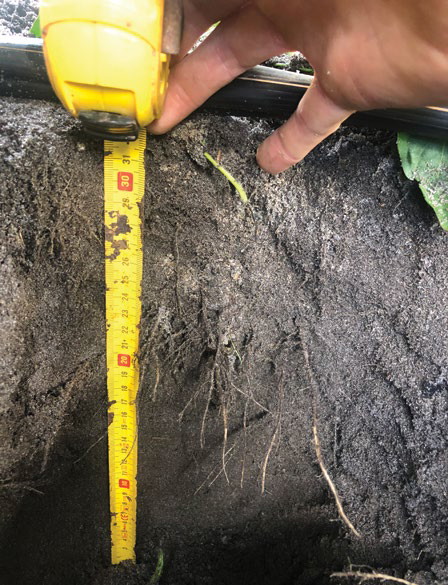Water and fertiliser use efficiency improvement
A VegNET WA extension service update
BY TRUYEN VO REGIONAL DEVELOPMENT OFFICER, VEGETABLESWA


TRUYEN Vo is working with growers to better understand soil moisture monitoring.
In the Summer 2020 edition of WA Grower magazine, we outlined the VegNET WA Strategy —a roadmap for enhancing WA vegetable growing businesses.
As part of this strategy, Western Australian (WA) VegNET Regional Development Officers (RDOs) will work closely with growers and stakeholders to create value by translating innovation into adoptable field practices.
As part of this project, we are looking at enhancing the efficiency of fertiliser by integrating soil moisture monitoring with knowledge on rootzone concept and soil characteristics to fine-tune the irrigation schedule.
The desired outcomes for this project are:
• Develop a strong task force to combine diverse resources and knowledge in irrigation technology.
• Implement a five-stage extension process to enhance growers’ decision-making and innovation adoption.
The five stages of this extension process include:
1 Knowledge: Introduce innovation to growers and help them understand the benefits.
2 Persuasion: Development of a favourable attitude to the innovation being introduced.
3 Decision: Gaining a commitment from growers to adopt the innovation.
4 Implementation: Growers putting the innovation into use via a trial-anderror process.
5 Confirmation: Reinforcement that the adoption yielded positive outcomes.
Developing a strong task force
The careful implementation of a stakeholder engagement plan has marked the first success step for this project and led to the formation of a strong task force in January 2021.
Members of the task force share common interests and are committed to contributing resources and knowledge in order to create value by translating new innovation into adoptable field practices.
This task force includes experts and scientists of the Department of Primary Industries and Regional Development (DPIRD), Perth Natural Resources Management (Perth NRM), Irrigation Australia, Wildeye Soil Moisture Monitoring and VegNET WA Regional Development Officers (RDOs).
Since January 2021, the task force has been working together to design field trials and demonstrations and setting them up at two grower properties in Wanneroo, WA.
Implementing field extension services
The plan to implement field trials that demonstrated the benefits of using soil monitoring technology, compared to conventional irrigation techniques growers normally use, was scheduled for February.
Unfortunately, this was delayed due to a COVID-19 lockdown and restrictions that prevented organising the grower meetings and field day events.
In April, the team was finally able to establish the first two field demonstrations.
The field demonstration sites include soil moisture monitoring probes installed at various depths to monitor the soil moisture profile over time, as well as introducing the rootzone concept and soil characteristics to growers.
The participating growers were assisted with downloading an app to their smartphones that allow them to read the soil moisture monitoring results, and better understand the data outputs presented in graph form (see Figure 1).
The growers were also presented with field observations of the rootzone and the soil texture at demonstration sites.
When we spoke with the participants about their conventional irrigation practices, we learned that water was being applied once every day for 1–2 hours through a medium flow drip tap (one litre of water per drip per hour).
Fertiliser was applied through fertigation every 2–3 days when crops were watered.
From the data outputted by the soil moisture monitoring, we learned that at the depth of 60cm the soil is as wet as soil at 30cm, when water is applied.

FIGURE 1. SOIL MOISTURE MONITORING RESULTS AT THE GROWER DEMONSTRATION SITE.

f THE rootzone within 30cm depth.
Reducing water wastage by using soil moisture monitoring.
Explanation provided by the RDO helped the growers to realise that water was leaking down beyond the rootzone, which meant that water, along with fertiliser, was being wasted.
Moreover, the fertiliser that was applied to the rootzone (at a 30cm depth) was being washed away by the water application on following days.
The grower has taken on board the RDO’s suggestion that he tries a new water and fertiliser application schedule and split the irrigation to water more than once a day, with shorter application times.
The trial aims to evaluate the benefits to the crop performance and to reduce water wastage by using soil moisture monitoring over the cropping season.
The RDO’s will continue working with DPIRD collaborators to estimate the value of saved water and fertiliser throughout the duration of the trial.
MORE INFORMATION